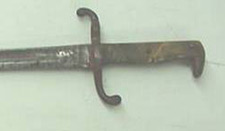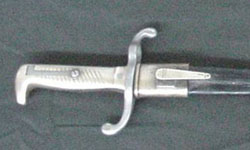|
Bavarian Bayonet


Before:
There was extensive iron oxidation on the bayonet's blade, hilt, tip and throat of the scabbard. Minimal corrosion on the blade and hilt allowed for full restoration. The scabbard's leather as extremely damage and no longer functioned. Torn seams and exposure to water resulted in the scabbard's “shrunken” appearance and no longer allows the bayonet to fit inside.

During:
Since the leather part of the scabbard was considerably reduced,
it was necessary for our leather restorer to conduct the repairs.
To preserve the original leather, it was repeatedly re-wetted and stretched until the scabbard was the size necessary for re-sewing. Iron-oxidation on the handle and blade was halted and successfully reversed.
After:
All traces of foreign residue were removed from the metal parts
of the scabbard while the bass tip and mouth were cleaned and repatinated.
|

